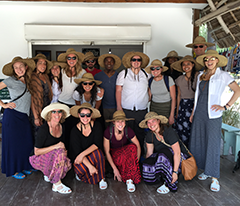This trip gets better and better. The beaches of Zanzibar don’t hurt. The first time I saw Zanzibar, I couldn’t really believe the color of the water. It’s incredible. Now I know it’s real, but it still takes my breath away every time I walk on the beach. I’m told there are only a few other places in the world that achieve the unreal hues of teal and blue that surround this island.  The shade of the water, the softness of the sand, and the ‘pole pole’ (slowly slowly) culture of Zanzibar make it a favorite destination of mine. I love sharing it with the students as well. We have many sea urchin injuries in the group as a result of the student’s ocean enthusiasm.
The shade of the water, the softness of the sand, and the ‘pole pole’ (slowly slowly) culture of Zanzibar make it a favorite destination of mine. I love sharing it with the students as well. We have many sea urchin injuries in the group as a result of the student’s ocean enthusiasm.
We started our Zanzibar experience at a sponge farm. Now you might think, what the heck is a sponge farm? Or you might think, what does a sponge farm have to do with global health? Exactly. The students think the same thing. That’s why we’re going to a sponge farm on this trip.
Let’s start with what a sponge farm is. As you likely know, sponges are living marine animals (unless you buy the synthetic ones at Target). While there are many varieties of sponges in the wild, only a few species are currently useful to humans. These sponges are farmed, although there are only 13 sponge farms in the world. The way you farm sponges is interesting. You create a grid of rope on buoys in the water – like a football field made entirely of rope and buoys. Then, you thread a piece of twine through a small sponge, and hang it on the rope frame. You do that with many small sponges. About a year later, each of these little sponges will have grown large enough to harvest. In the meantime, you have to keep the growing sponges happy by cleaning algae and seaweed off them. You also shave off stray parts of sponge that make it so it isn’t round. You use the shaved off pieces to start new sponges. That makes this is a sustainable business.
Why is a sponge farm a part of a global health trip? I’ll give you a hint. It doesn’t have anything to do with the function of the sponge. It has to do with the sustainability. In this part of the world, jobs are hard to come by. If you don’t have a job, you don’t have money to pay for food, clothing, or health care. And poverty is the largest threat to global health. Coming up with jobs that are sustainable, and support individuals or communities, is not easy. Often westerners come in with project ideas, the projects last one or two years, but then they end, and no one has money again. Sponge farming is a long-term venture. It provides jobs for several families in the community of Jambiani. In addition, the sponge farm community is working to protect the marine life of the region, teaching the other villagers about how to protect the reef, how to make octopus fishing sustainable, etc.
Are you ready for the fun part? Now that you know what sponge farming is, and why it’s important, let me tell you about our excursion. We showed up at the shore not quite knowing what to expect. Our guides, Tristan and Okala, had told us that we were likely going to get a little wet, maybe up to our shins or knees. But because we were in a Muslim village, we needed to wear longer skirts, cover our shoulders, and we should just bring a change of clothes. They outfitted all of us in Crocs (those rather ugly rubber shoes) and told us to beware of stepping on sea urchins. And then they told us to follow them. The tide was out as we set out across the coral and rock to the sponge farm.
I was following Paul, who was following Tristan. We twisted and turned as we picked our way through urchins and rock. Gradually, we were going through deeper and deeper pools of water. It was definitely over our shins. Initially, I tried to be creative and create shorts by pulling my skirt through my legs. But the ocean was having none of that. Eventually, I gave up. My skirt was just going to be wet. I looked ahead and noticed that Tristan was wearing a wet suit. He seemed oblivious to all of us women in our long skirts. When I watched the water hit the chest line of 6’5″ Paul in front of me as he stepped into a deep pool, I knew that it would be up to my shoulders. Sure enough. I gave up and swam through that pool, completely soaking my T-shirt and skirt. We waded through each pool with more and more giggling and laughing coming from the students behind me. I think one of them was even singing the Sponge-Bob Square Pants song.
I wondered if Tristan realized that we were all still in our land-wear, and then I looked at the mamas who were tending the sponges. They were wearing even more clothing than us – fully clothed, with even their heads covered. One mama was clearly curious about the water-logged mzungus out visiting the farm, as she would sneak glances at us through her swim mask from under water. At that point, I was glad that we were being culturally sensitive in our long skirts.
What I didn’t realize before we reached the farm was that we had three people in our group who had never been in the ocean before, two students and our translator/guide, Benson. All three of them were amazing. We gave them huge props for their courage as they reached the sponge farm – nearly neck deep in water while fully clothed. After getting our sponge lecture, Tristan and Okala gave us a few minutes to swim before heading in. Being from the Mowo area, our guide, 27 year-old Benson, had never been in the ocean, and did not swim. He wanted to learn. So, within that 10 minutes, we taught him to float, and began to teach him a front crawl. He picked up floating quickly. His crawl needs some work – but he can move in the water. I have never seen someone so excited to learn to swim. I think it may be one of the highlights of the trip.
We drug our water-sodden dripping bodies ashore where Okala’s family prepared us a feast of octopus, vegetables, pilau, and cassava. The food in Zanzibar has a lot more spice then other parts of the country because of the spice farms located here. Cardamon, cinnamon, lemongrass, and curcumin… It’s delicious.
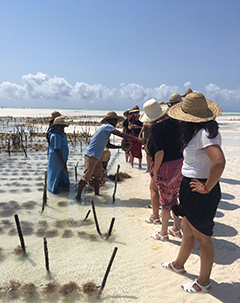 The Seaweed Center is a common stop for us on this trip. Like the sponge farm, is a sustainable business that is providing income for the village of Paje. The mamas who work in the center have increased their income from $1/day to $8/day – huge! – simply by turning seaweed into products instead of selling it wholesale. This year, we only had one day to spend with the seaweed mamas. Being that we always want to support the community, we asked the mamas what they wanted to do with the students this year. Overwhelmingly, the answer was massage. They wanted to get massages and learn how to massage each other. We could do that!
The Seaweed Center is a common stop for us on this trip. Like the sponge farm, is a sustainable business that is providing income for the village of Paje. The mamas who work in the center have increased their income from $1/day to $8/day – huge! – simply by turning seaweed into products instead of selling it wholesale. This year, we only had one day to spend with the seaweed mamas. Being that we always want to support the community, we asked the mamas what they wanted to do with the students this year. Overwhelmingly, the answer was massage. They wanted to get massages and learn how to massage each other. We could do that!
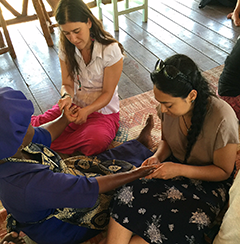 We spent an extra hour with two students per mama, giving hand massages, feet massages, and neck rubs. Then Merci, one of our students, led the mamas in some basic yoga, and Tessa, another student, led them in Qi Gong. When we said it was time to go, one of the mamas asked for additional exercises to tone her stomach. Other wanted push-up advice. So the students improvised a physical education activity. By the end of our time with them, the mamas were singing for the students and wishing they could come back the next day.
We spent an extra hour with two students per mama, giving hand massages, feet massages, and neck rubs. Then Merci, one of our students, led the mamas in some basic yoga, and Tessa, another student, led them in Qi Gong. When we said it was time to go, one of the mamas asked for additional exercises to tone her stomach. Other wanted push-up advice. So the students improvised a physical education activity. By the end of our time with them, the mamas were singing for the students and wishing they could come back the next day.
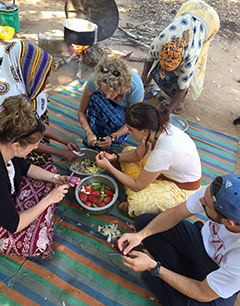 We spent Saturday at the Spice Farm – another favorite location of the students. This year, in addition to touring the farm and tasting everything from clove to cinnamon bark, Mr. Spice and his crew taught the students how to make local pilau and coconut curry sauce. Sitting on a grass mat in the dirt, the students peeled potatoes and eggplant, and shredded coconut. I wasn’t sure if the results of their cooking would be as good as that of Mr. Spice. However, he waited until they were done to add the seasoning. And yes, it was probably the best meal we will eat on Zanzibar. Adding fresh spices, straight from the farm, makes a huge difference in flavor.
We spent Saturday at the Spice Farm – another favorite location of the students. This year, in addition to touring the farm and tasting everything from clove to cinnamon bark, Mr. Spice and his crew taught the students how to make local pilau and coconut curry sauce. Sitting on a grass mat in the dirt, the students peeled potatoes and eggplant, and shredded coconut. I wasn’t sure if the results of their cooking would be as good as that of Mr. Spice. However, he waited until they were done to add the seasoning. And yes, it was probably the best meal we will eat on Zanzibar. Adding fresh spices, straight from the farm, makes a huge difference in flavor.
And then, I managed to get my annual infectious disease. This year, it was severe acute gastroenteritis. I knew I wasn’t feeling well when I threw up my breakfast. But it was to be our day in Stonetown, and I had many errands to run. So I rallied and got on the bus with the students and the rest of the crew. When we got to Stonetown, we set the students loose with tour guides, and Elizabeth and I went to the bank, and then to get ferry tickets for our trip back to Dar on Thursday. Through all of it, I was trying to overcome waves of nausea, and GI cramps. So after we got the essential chores done, I caught a taxi back to Paje. Usually, the drive is about 1.5 hours. My taxi driver looked at how green I was and did it in 45 minutes. We flew – literally caught air on some of the speed bumps – as he attempted to get me back before I threw up in his car.
Back in the hotel, I had an afternoon and night of misery. As all of my GI tract spasmed, I was vomiting and had horrible diarrhea. Of course, there is no privacy in Tanzania, so as I vomited, the mamas walked past my bathroom window saying, “Pole. Pole sana.” (Sorry, very sorry.) Meanwhile, I couldn’t keep anything down, including water. With as dehydrated as I was, I would have gone for an IV in the US. However, that wasn’t an option here. And the pain was excruciating. It felt like I was a real-live incubator for the alien movie. I kept waiting for a creature to emerge from my gut.
When everyone from our group returned, Paul diagnosed me with a staph GI infection. Funny enough, I’ve been teaching this infection for 20 years because it has a super-antigen. I’ve described the infection in detail; I’ve just never experienced it personally. I can honestly say I have new perspective.
Treatment? Well, it’s bacterial, but by the time you have these symptoms, the toxins have been released and there’s pretty much no point in taking an antibiotic, even though I had plenty with me. Also, I couldn’t swallow a pill. Instead, Paul worked his magic by rubbing two acupuncture points to decrease the pain. Amazing how effective that can be.
The illness lasted 24 hours, almost to the minute. Now I’m in recovery mode. I’ve been re-hydrating while the students are snorkeling and scuba diving. Fortunately, this was a planned day off for them.
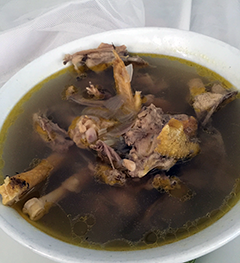 A little earlier, Julius went to town to get a chicken to make soup. Yes, a whole live chicken. TIA. There’s no ‘Campbell’s Chicken Noodle’ in these parts. I thanked him and laughed, saying, I will probably get soup in about five hours. OK, so it only took three hours… And it’s quite literally the whole chicken in the soup. It’s probably the most expensive chicken soup I’ll ever eat at 25,000 shillings ($12), but also probably the most healing.
A little earlier, Julius went to town to get a chicken to make soup. Yes, a whole live chicken. TIA. There’s no ‘Campbell’s Chicken Noodle’ in these parts. I thanked him and laughed, saying, I will probably get soup in about five hours. OK, so it only took three hours… And it’s quite literally the whole chicken in the soup. It’s probably the most expensive chicken soup I’ll ever eat at 25,000 shillings ($12), but also probably the most healing.
I’m going back to bed. I’m hoping to be at full-strength tomorrow because our next two days are clinic days with HIPZ. We’ll be touring clinics and going on grand rounds with the doctors.
Wishing you days of sun and sand and teal blue waters!
Heather
